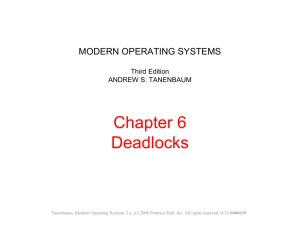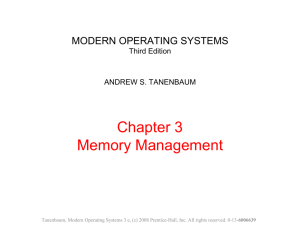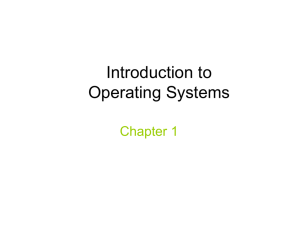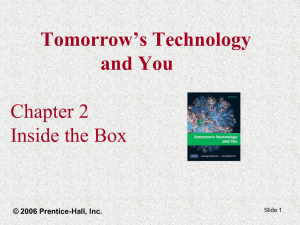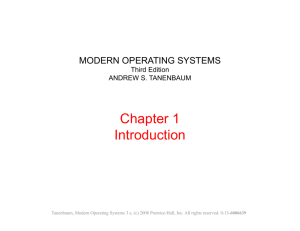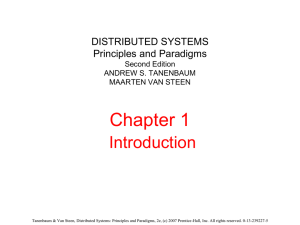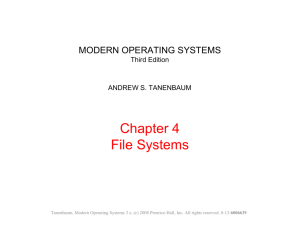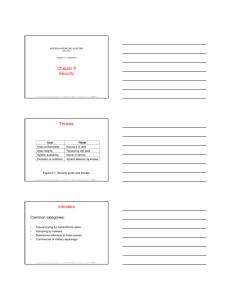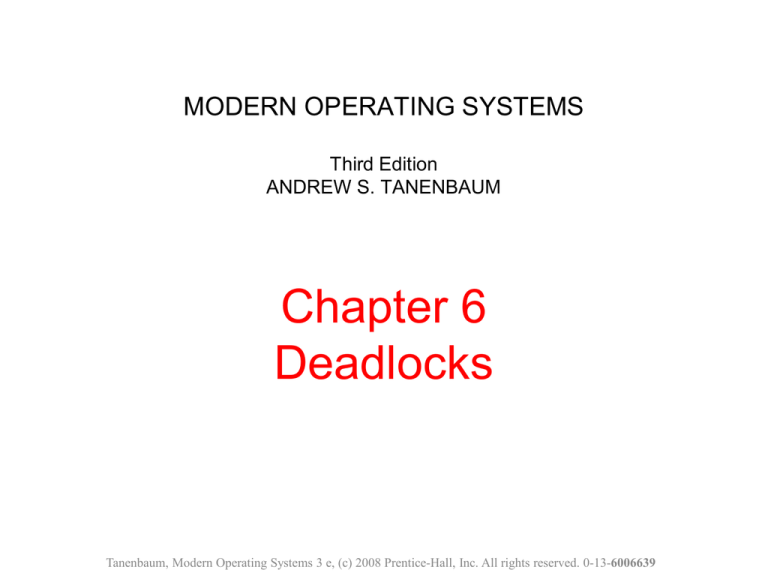
MODERN OPERATING SYSTEMS
Third Edition
ANDREW S. TANENBAUM
Chapter 6
Deadlocks
Tanenbaum, Modern Operating Systems 3 e, (c) 2008 Prentice-Hall, Inc. All rights reserved. 0-13-6006639
Preemptable and Nonpreemptable
Resources
Sequence of events required to use a
resource:
1. Request the resource.
2. Use the resource.
3. Release the resource.
Tanenbaum, Modern Operating Systems 3 e, (c) 2008 Prentice-Hall, Inc. All rights reserved. 0-13-6006639
Resource Acquisition (1)
Figure 6-1. Using a semaphore to protect resources.
(a) One resource. (b) Two resources.
Tanenbaum, Modern Operating Systems 3 e, (c) 2008 Prentice-Hall, Inc. All rights reserved. 0-13-6006639
Resource Acquisition (2)
Figure 6-2. (a)
Deadlock-free
code.
Tanenbaum, Modern Operating Systems 3 e, (c) 2008 Prentice-Hall, Inc. All rights reserved. 0-13-6006639
Resource Acquisition (3)
Figure 6-2. (b) Code with a
potential deadlock.
Tanenbaum, Modern Operating Systems 3 e, (c) 2008 Prentice-Hall, Inc. All rights reserved. 0-13-6006639
Introduction To Deadlocks
Deadlock can be defined formally as follows:
A set of processes is deadlocked if each
process in the set is waiting for an event
that only another process in the set can
cause.
Tanenbaum, Modern Operating Systems 3 e, (c) 2008 Prentice-Hall, Inc. All rights reserved. 0-13-6006639
Conditions for Resource Deadlocks
1.
2.
3.
4.
Mutual exclusion condition
Hold and wait condition.
No preemption condition.
Circular wait condition.
Tanenbaum, Modern Operating Systems 3 e, (c) 2008 Prentice-Hall, Inc. All rights reserved. 0-13-6006639
Deadlock Modeling (1)
Figure 6-3. Resource allocation graphs. (a) Holding a resource.
(b) Requesting a resource. (c) Deadlock.
Tanenbaum, Modern Operating Systems 3 e, (c) 2008 Prentice-Hall, Inc. All rights reserved. 0-13-6006639
Deadlock Modeling (2)
Figure 6-4. An example of how deadlock occurs
and how it can be avoided.
Tanenbaum, Modern Operating Systems 3 e, (c) 2008 Prentice-Hall, Inc. All rights reserved. 0-13-6006639
Deadlock Modeling (3)
Figure 6-4. An example of how deadlock occurs
and how it can be avoided.
Tanenbaum, Modern Operating Systems 3 e, (c) 2008 Prentice-Hall, Inc. All rights reserved. 0-13-6006639
Deadlock Modeling (4)
Figure 6-4. An example of how deadlock occurs
and how it can be avoided.
Tanenbaum, Modern Operating Systems 3 e, (c) 2008 Prentice-Hall, Inc. All rights reserved. 0-13-6006639
Deadlock Modeling (5)
Strategies for dealing with deadlocks:
1. Just ignore the problem.
2. Detection and recovery. Let deadlocks
occur, detect them, take action.
3. Dynamic avoidance by careful resource
allocation.
4. Prevention, by structurally negating one
of the four required conditions.
Tanenbaum, Modern Operating Systems 3 e, (c) 2008 Prentice-Hall, Inc. All rights reserved. 0-13-6006639
Deadlock Detection with
One Resource of Each Type (1)
Figure 6-5. (a) A resource graph. (b) A cycle extracted from (a).
Tanenbaum, Modern Operating Systems 3 e, (c) 2008 Prentice-Hall, Inc. All rights reserved. 0-13-6006639
Deadlock Detection with
One Resource of Each Type (2)
Algorithm for detecting deadlock:
1. For each node, N in the graph, perform the
following five steps with N as the starting node.
2. Initialize L to the empty list, designate all arcs
as unmarked.
3. Add current node to end of L, check to see if
node now appears in L two times. If it does,
graph contains a cycle (listed in L), algorithm
terminates.
…
Tanenbaum, Modern Operating Systems 3 e, (c) 2008 Prentice-Hall, Inc. All rights reserved. 0-13-6006639
Deadlock Detection with
One Resource of Each Type (3)
4. From given node, see if any unmarked
outgoing arcs. If so, go to step 5; if not, go to
step 6.
5. Pick an unmarked outgoing arc at random and
mark it. Then follow it to the new current node
and go to step 3.
6. If this is initial node, graph does not contain any
cycles, algorithm terminates. Otherwise, dead
end. Remove it, go back to previous node,
make that one current node, go to step 3.
Tanenbaum, Modern Operating Systems 3 e, (c) 2008 Prentice-Hall, Inc. All rights reserved. 0-13-6006639
Deadlock Detection with Multiple
Resources of Each Type (1)
Figure 6-6. The four data structures needed
by the deadlock detection algorithm.
Tanenbaum, Modern Operating Systems 3 e, (c) 2008 Prentice-Hall, Inc. All rights reserved. 0-13-6006639
Deadlock Detection with Multiple
Resources of Each Type (2)
Deadlock detection algorithm:
1. Look for an unmarked process, Pi , for which
the i-th row of R is less than or equal to A.
2. If such a process is found, add the i-th row of C
to A, mark the process, and go back to step 1.
3. If no such process exists, the algorithm
terminates.
Tanenbaum, Modern Operating Systems 3 e, (c) 2008 Prentice-Hall, Inc. All rights reserved. 0-13-6006639
Deadlock Detection with Multiple
Resources of Each Type (3)
Figure 6-7. An example for the deadlock detection algorithm.
Tanenbaum, Modern Operating Systems 3 e, (c) 2008 Prentice-Hall, Inc. All rights reserved. 0-13-6006639
Recovery from Deadlock
• Recovery through preemption
• Recovery through rollback
• Recovery through killing processes
Tanenbaum, Modern Operating Systems 3 e, (c) 2008 Prentice-Hall, Inc. All rights reserved. 0-13-6006639
Deadlock Avoidance
Figure 6-8. Two process resource trajectories.
Tanenbaum, Modern Operating Systems 3 e, (c) 2008 Prentice-Hall, Inc. All rights reserved. 0-13-6006639
Safe and Unsafe States (1)
Figure 6-9. Demonstration that the state in (a) is safe.
Tanenbaum, Modern Operating Systems 3 e, (c) 2008 Prentice-Hall, Inc. All rights reserved. 0-13-6006639
Safe and Unsafe States (2)
Figure 6-10. Demonstration that the state in (b) is not safe.
Tanenbaum, Modern Operating Systems 3 e, (c) 2008 Prentice-Hall, Inc. All rights reserved. 0-13-6006639
The Banker’s Algorithm
for a Single Resource
Figure 6-11. Three resource allocation states:
(a) Safe. (b) Safe. (c) Unsafe.
Tanenbaum, Modern Operating Systems 3 e, (c) 2008 Prentice-Hall, Inc. All rights reserved. 0-13-6006639
The Banker’s Algorithm
for Multiple Resources (1)
Figure 6-12. The banker’s algorithm with multiple resources.
Tanenbaum, Modern Operating Systems 3 e, (c) 2008 Prentice-Hall, Inc. All rights reserved. 0-13-6006639
The Banker’s Algorithm
for Multiple Resources (2)
Algorithm for checking to see if a state is safe:
1. Look for row, R, whose unmet resource needs all
≤ A. If no such row exists, system will eventually
deadlock since no process can run to completion
2. Assume process of row chosen requests all resources
it needs and finishes. Mark process as terminated, add
all its resources to the A vector.
3. Repeat steps 1 and 2 until either all processes marked
terminated (initial state was safe) or no process left
whose resource needs can be met (there is a
deadlock).
Tanenbaum, Modern Operating Systems 3 e, (c) 2008 Prentice-Hall, Inc. All rights reserved. 0-13-6006639
Deadlock Prevention
•
•
•
•
Attacking the mutual exclusion condition
Attacking the hold and wait condition
Attacking the no preemption condition
Attacking the circular wait condition
Tanenbaum, Modern Operating Systems 3 e, (c) 2008 Prentice-Hall, Inc. All rights reserved. 0-13-6006639
Attacking the
Circular Wait Condition
Figure 6-13. (a) Numerically ordered resources.
(b) A resource graph.
Tanenbaum, Modern Operating Systems 3 e, (c) 2008 Prentice-Hall, Inc. All rights reserved. 0-13-6006639
Approaches to Deadlock Prevention
Figure 6-14. Summary of approaches to deadlock prevention.
Tanenbaum, Modern Operating Systems 3 e, (c) 2008 Prentice-Hall, Inc. All rights reserved. 0-13-6006639
Other Issues
•
•
•
•
Two-phase locking
Communication deadlocks
Livelock
Starvation
Tanenbaum, Modern Operating Systems 3 e, (c) 2008 Prentice-Hall, Inc. All rights reserved. 0-13-6006639
Communication Deadlocks
Figure 6-15. A resource deadlock in a network.
Tanenbaum, Modern Operating Systems 3 e, (c) 2008 Prentice-Hall, Inc. All rights reserved. 0-13-6006639
Livelock
Figure 6-16. Busy waiting that can lead to livelock.
Tanenbaum, Modern Operating Systems 3 e, (c) 2008 Prentice-Hall, Inc. All rights reserved. 0-13-6006639

